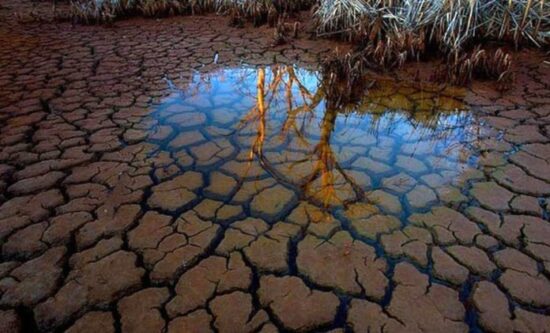Pollution, climate change and overuse are stretching groundwater sources to the limit according to a study published on January 24, 2024, in the journal Nature.
Groundwater is a source of drinking and irrigation water. It gets used by industries as well. But wastewater from cities and towns, runoff containing pesticides and fertilizer chemicals from farms, and chemicals and dissolved heavy metals from industry make groundwater sources increasingly polluted.
Groundwater aquifers near coastlines where most humans live are threatened by rising sea levels leading to seawater intrusion. And where coastal communities reside without surface water sources or desalination plants, groundwater is almost exclusively the source of fresh water.
Groundwater sources are also being affected by changes in climate conditions. Dry regions that rely on them are most at risk. The American Midwest and Central Valley of California are particularly at risk of groundwater level decline.
Eyes in the Sky Study Groundwater Levels
In 2002, NASA and Germany’s space program, DLR, sent twin satellites into polar orbits spaced 220 kilometres (approximately 137 miles) apart. The twins were named GRACE, short for Gravity Recovery and Climate Experiment. Their purpose was to study changes to Earth’s gravity field and investigate sources of water on and under land, ice and oceans. GRACE instrumentation measured changes to the Earth’s surface from ground deformation caused by declining aquifers, earthquakes and glacial isostatic adjustments. It tracked changes to deep currents in the ocean, runoff and groundwater storage on land and the discharge of water from ice sheets and glaciers into the ocean.
The GRACE mission was to last five years but the two satellites eventually were decommissioned by the end of 2017. GRACE-FO was launched in 2018 to continue the work of the original satellites. The two successor satellites track gravitational changes affecting global sea levels, glaciers, ice sheets, lakes and river water levels. The satellites also measure soil moisture and provide 200 profiles daily of atmospheric temperature and water vapour distribution. Measurements as small as 10 micrometres (one-tenth of a human hair) to surface changes are captured and recorded.
Study Results Indicate Rapid Groundwater Depletion
The study published in Nature analyzed groundwater-level trends from 1,693 aquifers and approximately 170,000 wells in more than 40 countries. The measurements showed a “prevalence of rapid and accelerating groundwater-level declines and their correlation with land use and climatic drivers.” In some areas where government policy changes and inter-basin water transfers were conducted, aquifers showed some levels of recovery.
In 36% of aquifer systems, the study noted groundwater level drops exceeding 0.5 metres (nearly 20 inches) annually. In 6%, groundwater levels showed a rise of up to 0.1 metres (nearly 4 inches), and 1% indicated a rise of 0.5 metres (20 inches). The data was compared to analysis done in the late 20th century in 542 of the 1,693 aquifers. Of these, 30% showed accelerated groundwater-level declines at a rate more than twice what the researchers expected would be prevalent based on random fluctuations.
Groundwater Restoration Successes Are Few
The study noted that there was potential to slow or reverse losses. It gave several examples including:
- a marked deceleration in groundwater-level drops in the Eastern Saq aquifer of Saudi Arabia because of policies enacted to reduce agricultural water demands.
- a reversal in groundwater levels in the Bangkok Basin in Thailand attributed to changes in regulations on water use.
- a positive change in groundwater levels in the Abbas-e Sharghi Basin in Iran because of changes to groundwater pumping fees and licensing of wells.
- an improvement in groundwater levels west of Tucson, Arizona with the implementation of managed aquifer recharge projects.
Agricultural Demands Are A Groundwater Challenge
Unfortunately, these examples are too few to reverse the overall trend of groundwater-level decline which is particularly noticeable under cultivated lands in drier climates. Why? Because irrigation accounts for 70% of global groundwater withdrawals today. This imposes a significant stress on dryland aquifers which if depleted take much longer to recover than aquifers in wetter climates.
Global warming is making drylands get drier. For the American Midwest, the great fear is a return to The Dust Bowl conditions of the 1930s that followed a period of above-average precipitation lasting nearly a decade. This led to the rapid expansion of farming in the region. In the 1930s, not only did the Midwest suffer from The Great Depression, but it also experienced an eight-year drought creating a perfect economic and climate storm. Abandoned farms became semi-desert and more than 850 million tons of soil from unattended fields blew away. This happened before the discovery of the ten-million-year-old Ogallala Aquifer underlying the region.
That Ogallala plus the return of rain to the Midwest revived the farm belt. But since 2012, persistent drought has returned. Thousands of wells today tap the Ogallala which is losing groundwater faster than it can be restored through natural processes.
The adoption of new methods for agricultural practices in water-stressed areas of the planet may slow the groundwater decline, but only the return of the rains will save the American Midwest’s farms. As for restoring groundwater levels, a concerted effort to mitigate climate change can only help.









